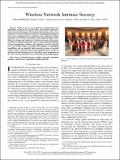Wireless Network Intrinsic Secrecy
Author(s)
Rabbachin, Alberto; Conti, Andrea; Win, Moe Z.
DownloadWin_Wireless network.pdf (2.902Mb)
OPEN_ACCESS_POLICY
Open Access Policy
Creative Commons Attribution-Noncommercial-Share Alike
Terms of use
Metadata
Show full item recordAbstract
Wireless secrecy is essential for communication confidentiality, health privacy, public safety, information superiority, and economic advantage in the modern information society. Contemporary security systems are based on cryptographic primitives and can be complemented by techniques that exploit the intrinsic properties of a wireless environment. This paper develops a foundation for design and analysis of wireless networks with secrecy provided by intrinsic properties such as node spatial distribution, wireless propagation medium, and aggregate network interference. We further propose strategies that mitigate eavesdropping capabilities, and we quantify their benefits in terms of network secrecy metrics. This research provides insights into the essence of wireless network intrinsic secrecy and offers a new perspective on the role of network interference in communication confidentiality.
Date issued
2015-02Department
Massachusetts Institute of Technology. Department of Aeronautics and Astronautics; Massachusetts Institute of Technology. Laboratory for Information and Decision SystemsJournal
IEEE/ACM Transactions on Networking
Publisher
Institute of Electrical and Electronics Engineers (IEEE)
Citation
Rabbachin, Alberto, Andrea Conti, and Moe Z. Win. “Wireless Network Intrinsic Secrecy.” IEEE/ACM Transactions on Networking 23, no. 1 (February 2015): 56–69.
Version: Author's final manuscript
ISSN
1063-6692
1558-2566